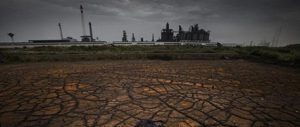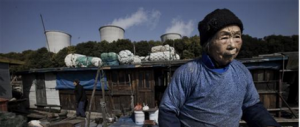A hidden epidemic is poisoning America. The toxins are in the air we breathe and the water we drink, in the walls of our homes and the furniture within them. We can’t escape it in our cars. It’s in cities and suburbs. It afflicts rich and poor, young and old. And there’s a reason why you’ve never read about it in the newspaper or seen a report on the nightly news: it has no name – and no antidote.
The culprit behind this silent killer is lead. And vinyl. And formaldehyde. And asbestos. And Bisphenol A. And polychlorinated biphenyls (PCBs). And thousands more innovations brought to us by the industries that once promised “better living through chemistry”, but instead produced a toxic stew that has made every American a guinea pig and has turned the United States into one grand unnatural experiment.
Today, we are all unwitting subjects in the largest set of drug trials ever. Without our knowledge or consent, we are testing thousands of suspected toxic chemicals and compounds, as well as new substances whose safety is largely unproven and whose effects on human beings are all but unknown. The Centers for Disease Control (CDC) itself has begun monitoring our bodies for 151 potentially dangerous chemicals, detailing the variety of pollutants we store in our bones, muscle, blood and fat.
None of the companies introducing these new chemicals has even bothered to tell us we’re part of their experiment. None of them has asked us to sign consent forms or explained that they have little idea what the long-term side effects of the chemicals they’ve put in our environment – and so our bodies – could be. Nor do they have any clue as to what the synergistic effects of combining so many novel chemicals inside a human body in unknown quantities might produce.
How industrial toxins entered our homes
The story of how Americans became unwitting test subjects began more than a century ago. The key figure was Alice Hamilton, the “mother” of American occupational medicine, who began documenting the way workers in lead paint pigment factories, battery plants and lead mines were suffering terrible palsies, tremors, convulsions and deaths after being exposed to lead dust that floated in the air, coating their workbenches and clothes.
Soon thereafter, children exposed to lead paint and lead dust in their homes were also identified as victims of this deadly neurotoxin. Many went into convulsions and comas after crawling on floors where lead dust from paint had settled, or from touching lead-painted toys, or teething on lead-painted cribs, windowsills, furniture and woodwork.
Instead of levelling with the public, the lead industry, through its trade group the Lead Industries Association, began a six-decade campaign to cover-up its product’s dire effects. It challenged doctors who reported lead-poisoned children to health departments, distracted the public through advertisements that claimed lead was “safe” to use, and fought regulation of the industry by local government, all in the service of profiting from putting a poison in paint, gasoline, plumbing fixtures, and even toys, baseballs and fishing gear.
Only after thousands of children were poisoned and, in the 1960s, activist groups like the Young Lords and the Black Panthers began to use lead poisoning as a symbol of racial and class oppression did public health professionals and the federal government begin to rein in companies like the Sherwin-Williams paint company and the Ethyl Corporation, which produced tetraethyl lead, the lead-additive in gasoline.
In 1971, Congress passed the Lead Paint Poisoning Prevention Act that limited lead in paint used for public housing. In 1978, the Consumer Products Safety Commission finally banned lead in all paints sold for consumer use. During the 1980s, the Environmental Protection Agency issued rules that led to the elimination of leaded gasoline by 1995 (though it still remains in aviation fuel).
The CDC estimates that in at least 4 million households in the US today, children are still exposed to dangerous amounts of lead from old paint that produces dust every time a nail is driven into a wall to hang a picture, a new electric socket is installed or a family renovates its kitchen. It estimates that more than 500,000 children ages one to five have “elevated” levels of lead in their blood. (No level is considered safe for children). Studies have linked lost IQ points, attention deficit disorders, behavioural problems, dyslexia, and even possibly high incarceration rates to tiny amounts of lead in children’s bodies.
Unfortunately, when it came to the creation of America’s chemical soup, the lead industry was hardly alone. Asbestos is another classic example of an industrial toxin that found its way into people’s homes and bodies. For decades, insulation workers, brake mechanics, construction workers and a host of others in hundreds of trades fell victim to the disabling and deadly lung diseases of asbestosis or to lung cancer and the fatal cancer called mesothelioma when they breathed in dust produced during the installation of boilers, the insulation of pipes, the fixing of cars that used asbestos brake linings, or the spraying of asbestos on girders. Once again, the industry knew its product’s dangers early and worked assiduously to cover them up.
Today, however, these devastating industrial-turned-domestic toxins, which destroyed the health and sometimes took the lives of hundreds of thousands, seem almost quaint when compared to the brew of potential or actual toxins we’re regularly ingesting in the air we breathe, the water we drink and the food we eat.
Of special concern are a variety of chlorinated hydrocarbons, including DDT and other pesticides that were once spread freely nationwide, and despite being banned decades ago, have accumulated in the bones, brains and fatty tissue of virtually all of us. Their close chemical carcinogenic cousins, polychlorinated biphenyls (PCBs), were found in innumerable household and consumer products – like carbonless copy paper, adhesives, paints, and electrical equipment – from the 1950s through to the 1970s. We’re still paying the price for that industrial binge today, as these odourless, tasteless compounds have become permanent pollutants in the natural environment and, as a result, in all of us.
The largest uncontrolled experiment in history
While old houses with lead paint and asbestos shingles pose risks, potentially more frightening chemicals are lurking in new construction. Our homes are now increasingly made out of lightweight fibres and reinforced synthetic materials whose effects on human health have never been adequately studied individually, let alone in the combinations we’re all subjected to today.
Formaldehyde, a colourless chemical used in mortuaries as a preservative, can also be found as a fungicide, germicide and disinfectant in, for example, plywood, particle board, hardwood panelling, and the “medium density fiberboard” commonly used for the fronts of drawers and cabinets or the tops of furniture. As the material ages, it evaporates into the home as a known cancer-producing vapour, which slowly accumulates in our bodies.
While the flame retardants commonly used in sofas, chairs, carpets, love seats, curtains, baby products, and even TVs, sounded like a good idea when widely introduced in the 1970s, they turn out to pose hidden dangers that we’re only now beginning to grasp. Researchers have, for instance, linked one of the most common flame retardants, polybrominated diphenyl ethers, to a wide variety of potentially undesirable health effects including thyroid disruption, memory and learning problems, delayed mental and physical development, lower IQ and the early onset of puberty.
Other flame retardants like Tris (1,3-dichloro-2-propyl) phosphate have been linked to cancer. As the CDC has documented in an ongoing study of the accumulation of hazardous materials in our bodies, flame retardants can now be found in the blood of “nearly all” of us.
These synthetic materials are just a few of the thousands now firmly embedded in our lives and our bodies. Most have been deployed in our world and put in our air, water, homes and fields without being studied at all for potential health risks, nor has much attention been given to how they interact in the environments in which we live, let alone our bodies.
The groups that produce these miracle substances – like the petrochemical, plastics, and rubber industries, including major companies like Exxon, Dow and Monsanto – argue that, until we can definitively prove the chemical products slowly leaching into our bodies are dangerous, we have no “right” and they have no obligation, to remove them from our homes and workplaces. The idea that they should prove their products safe before exposing the entire population to them seems to be a foreign concept.
In the 1920s, the oil industry made the same argument about lead as an additive in gasoline, even though it was already known that it was a dangerous toxin for workers. Spokesman for companies like General Motors insisted that it was a “gift of God”, irreplaceable and essential for industrial progress and modern living.
Like the oil, lead, and tobacco industries of the twentieth century, the chemical industry, through the American Chemistry Council and public relations firms like Hill & Knowlton, is fighting tooth and nail to stop regulation and inhibit legislation that would force it to test chemicals before putting them in the environment.
There can be no doubt that this is the largest uncontrolled experiment in history. To begin to bring it under control would undoubtedly involve major grassroots efforts to push back against the offending corporations, courageous politicians, billions of dollars and top-flight researchers. But before any serious steps are likely to be taken, before we even name this epidemic, we need to wake up to its existence.
David Rosner and Gerald Markowitz are the authors of Lead Wars: The Politics of Science and the Fate of America’s Children.
This article was first published by TomDispatch.com
Copyright 2013 David Rosner and Gerald Markowitz





